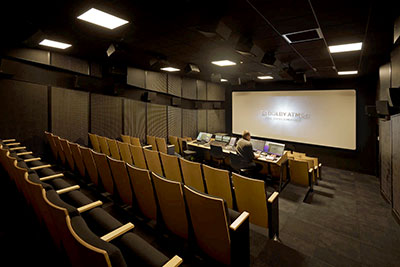Part of University College South Denmark, Sonic College has provided a hub for students considering a career in sound design since its opening in 2010. Having moved into a new, purpose-built campus last September, has seen Dolby Atmos immersive audio gaining ground in film, TV and gaming applications with Merging Technologies equipment used to streamline production.
‘As a teenager, I dreamt of being a keyboard player in a band, so my background is in music,’ says Lars Tirsbæk, a verified audio expert and lecturer at Sonic College. ‘I had taken some pre-conservatory courses, and when I applied to join the conservatory, I began to think about what I really wanted to do. I love playing music, but I also enjoyed working with synthesisers and creating sounds with things like vocal processing on stage.’
 Between 2011 and 2015, he completed a programme in sound design at Sonic College after which the programme head asked if he wanted to teach on the same course – marking the start of his teaching career. He began as a guest lecturer in recording technologies and music production and progressed into a full-time position. When the college moved to its new campus, Tirsbæk was put in charge of the build, as well as the studio spec and design.
Between 2011 and 2015, he completed a programme in sound design at Sonic College after which the programme head asked if he wanted to teach on the same course – marking the start of his teaching career. He began as a guest lecturer in recording technologies and music production and progressed into a full-time position. When the college moved to its new campus, Tirsbæk was put in charge of the build, as well as the studio spec and design.
The new facility includes a Dolby Atmos dubbing stage and a cinema playback room allowing students to learn sound design, mixing and playback of theatrical content. Equipped with 40 Meyer Sound loudspeakers, a Pro Tools DAW with rendering and mastering capabilities, and an Avid console, they have everything needed for Dolby Atmos production. Additionally, there is an 80-seat cinema, a Foley stage with a Neumann system, two mastering studios, two stereo editing studios, a well equipped recording studio, a synthesiser lab, and an immersive atrium featuring 180 loudspeakers.
Critical listening sessions are housed in purpose-built 7.1 classrooms, which accommodate up to 40 students. For monitoring and streaming, they use the Merging Anubis as a versatile monitor controller. It serves as a hybrid set-up, allowing them to route audio inputs and outputs efficiently, including microphone feeds for online lectures via platforms such as Zoom.
‘The Anubis meets our college’s diverse connectivity needs, accommodating lecturers with their own sound cards and offering line inputs for additional flexibility,’ Tirsbæk explains. ‘Its adaptability is invaluable in a sound college setting, particularly due to its network-based capabilities, which are not widely available in other controllers.’
The college’s encounter with the Anubis began in 2020 when looking for a hybrid teaching approach, combining in-person and remote learning. It required a monitor controller capable of handling multiple inputs, immersive formats and multichannel inputs. Using AES67 and Dante devices, it is possible to seamlessly connect various audio sources to the Anubis, allowing users to undertake different types of projects. Given the diverse needs of a sound college, the Anubis proved indispensable, offering versatility and adaptability.
Sonic College has incorporated a further Anubis into its Dolby Atmos mastering suite, where it serves as a monitor controller. Here, students work on Atmos projects for film, music and gaming. Using a home entertainment receiver, they output 7.1.4 analogue audio into a converter and then connect it to the network. This allows the incorporation of an Xbox, a computer running Unity and Wwise middleware for gaming projects, and a Mac Pro running Pro Tools. Through the Anubis, students can switch between listening to system audio, output from the home entertainment receiver, and signals from the Dolby render unit. Additionally, the Anubis plays is the calibration point for the entire system, facilitating tasks such as EQ, delay, and bass management.
‘The interface of the Anubis allows students to seamlessly work with immersive audio as if it were a stereo signal, remaining accommodating to the immersive age our students were born into and are used to,’ Tirsbæk says. ‘Outdated feature sets from a decade ago pale in comparison, where the inability to solo or mute speakers in an immersive format on a monitor controller seems unimaginable. There are some interesting things going on there and the Anubis was one of the pioneers in enabling such functionalities. Students quickly grasp its usage, appreciating its versatility and extensive feature set, and we strive to ensure they grasp the full range of capabilities it offers.’
More: www.merging.com














